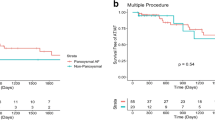Abstract
The prevalence of atrial fibrillation increases significantly with age, affecting nearly 10 % of adults greater than 80 years of age. Complications from atrial fibrillation, including stroke, also increase with age. Medical therapy includes anticoagulation, ventricular rate control, and if symptoms persist, maintenance of sinus rhythm with antiarrhythmic drugs. However, anticoagulation and antiarrhythmic therapy is often challenging in the elderly due to side effects, comorbidities, and heightened sensitivity to medications. Catheter based ablation of atrial fibrillation is an effective treatment for paroxysmal atrial fibrillation. However, the major randomized controlled trials, such as Thermocool AF and STOP-AF studies, have excluded the elderly patients. Current guidelines suggest caution when considering ablation for elderly patients due to a lack of available data. We will review recent studies that have observed the outcomes of atrial fibrillation ablation in the elderly, specifically those studies that included octogenarians.
Similar content being viewed by others
References
Papers of particular interest have been highlighted as: • Of importance •• Of major importance
Williams E, Hall B, Traub D, Bahnson T, Hranitzky P, Zareba W, et al. Catheter ablation of atrial fibrillation in elderly. Curr Opin Cardiol. 2011;26:25–9.
Sankaranarayanan R, Kirkwood G, Dibb K, Clifford G. Comparison of atrial fibrillation in the young vs that in elderly: a review. Cardiol Res Pract. 2013;2012:1–16.
Marinigh R, Lip GH, Fiotti N, Giansante C, Lane DA. Age as a risk factor for stroke in atrial fibrillation patients: implications for thromboprophylaxis. J Am Coll Cardiol. 2010;56:827–37.
•• Santangeli P, Biase L, Mohanty P, Burkhardt D, Horton R, Bai R, et al. Catheter ablation of atrial fibrillation in octogenarians: safety and outcomes. J Cardiovasc Electrophysiol. 2012;23:687–93. Comparison of AF ablation outcomes based on AF type between younger (<80 years) and older (>80 year) patients.
Coppens M, Eikelboom J, Hart R, Yusuf S, Lip G, Dorian P, et al. The CHA2DS2-VASc score identifies those patients with atrial fibrillation and a CHADS2 score of 1 who are unlikely to benefit from oral anticoagulant therapy. Eur Heart J. 2013;34:170–6.
Traub D, Daubert J, McNitt S, Zareba W, Hall B. Catheter ablation of atrial fibrillation in the elderly: where do we stand? Cardiol J. 2009;16:113–20.
Ruskin JN. The cardiac arrhythmia suppression trial (CAST). N Engl J Med. 1988;321:386–8.
Zimetbaum P. Amiodarone for atrial fibrillation. N Engl J Med. 2007;356:935–41.
• Calkins H, Kuck K, Cappato R, Brugada J, Camm J, Chen S, et al. HRS/EHRA/ECAS Expert consensus statement on catheter and surgical ablation of atrial fibrillation: recommendations for patient selection, procedural techniques, patient management and follow-up, definitions, endpoints, and research. Hear Rhythm. 2012;2012(9):632–96. These are the latest guidelines for treating atrial fibrillation with catheter ablation.
Corrado A, Patel D, Riedlbauchova L, Fahmy T, Themistoclakis S, Bonso A, et al. Efficacy, safety, and outcome of atrial fibrillation ablation in septuagenarians. J Cardiovasc Electrophysiol. 2008;19:807–11.
• Zado E, Callans D, Riley M, Hutchinson M, Garcia F, Bala, et al. Long–term clinical efficacy and risk of catheter ablation for atrial fibrillation in the elderly. J Cardiovasc Electrophysiol. 2008;19:621–6. Large retrospective study of AF ablation in elderly patients compared with younger groups.
Wilber D, Pappone C, Neuzil P, Paola A, Marchlinski F, Natale A, et al. Thermocool AF trial investigators: comparison of antiarrhythmic drug therapy and radiofrequency catheter ablation in patients with paroxysmal atrial fibrillation: a randomized controlled trial. JAMA. 2010;303:333–40.
Packer DL, Irwin JM, Champagne J, et al. Cryoballoon ablation of pulmonary veins for paroxysmal atrial fibrillation: first results of the North American Arctic Front STOP-AF clinical trial. Atlanta: American College of Cardiology Annual Scientific Section; 2010.
• Bunch TJ, Weiss JP, Crandall BG, May HT, Bair TL, Osborn JS, et al. Long–term clinical efficacy and risk of catheter ablation for atrial fibrillation in octogenarians. Pacing Clin Electrophysiol. 2010;33:146–52. Large retrospective study of AF ablation in elderly patients compared with younger groups.
Shah R, Freeman J, Shilane D, Wang P, Go A, Hlatky M. Procedural complications, rehospitalizations, and repeat procedures after catheter ablation for atrial fibrillation. J Am Coll Cardiol. 2012;59:143–9.
Lim T, Day J, Weiss P, Crandall B, May H, Bair T, et al. More aggressive left atrial ablation in elderly patients does not increase procedural complications and favorably impacts outcomes. J Card Rhythm Manage. 2011;2:206–11.
Wann L, Curtis A, January CT, Ellenbogen K, Lowe J, Estes M, et al. ACCF/AHA/HRS focused update on the management of patients with atrial fibrillation (Updating the 2006 Guideline): a report of the American College of Cardiology Foundation/American Heart Association Task Force on Practice Guidelines. J Am Coll Cardiol. 2011;57:223–42.
Epstein E, Vidaillet H, Greene L, Curtis B, Ellenbogen A, Simmons T, et al. Frequency of symptomatic atrial fibrillation in patients enrolled in the Atrial Fibrillation Follow-up Investigation of Rhythm Management (AFFIRM) Study. J Cardiovasc Electrophysiol. 2002;13:667–71.
Compliance with ethics Guidelines
Conflict of Interest
Gevorg Stepanyan declares that he has no conflict of interest.
Edward P. Gerstenfeld has received grant support from Rhythmia Medical, Biosense Webster; and has received honoraria from Medtronic, Biosense Webster, St. Jude Medical, and Voyage Medical.
Human and Animal Rights and Informed Consent
This article does not contain any studies with human or animal subjects performed by any of the authors.
Author information
Authors and Affiliations
Corresponding author
Additional information
This article is part of the Topical Collection on Invasive Electrophysiology and Pacing
Rights and permissions
About this article
Cite this article
Stepanyan, G., Gerstenfeld, E.P. Atrial Fibrillation Ablation in Octogenarians: Where Do We Stand?. Curr Cardiol Rep 15, 406 (2013). https://doi.org/10.1007/s11886-013-0406-y
Published:
DOI: https://doi.org/10.1007/s11886-013-0406-y




